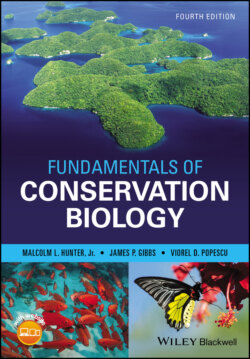Читать книгу Fundamentals of Conservation Biology - Malcolm L. Hunter Jr. - Страница 67
The Uniqueness Value of Species
ОглавлениеImagine a question on your vertebrate zoology final: What do the aardvark and bowfin have in common? “They are both vertebrate animals” might get you grudging partial credit. “They are the only species in their respective orders: Tubulidentata and Amiiformes” would certainly earn you full credit. These are two special species because they are unique at the taxonomic level of an order, a level of taxonomy that also encompasses such large groups as rodents (Rodentia, c. 2300 species), songbirds (Passeriformes, c. 5300 species), and perches and their relatives (Perciformes, c. 10,000 species) (Fig. 3.13). Similarly, there are dozens of taxonomic families represented by just one or two species. We could argue about artificiality of taxonomic classifications, but in the end we would agree that a white‐eyed vireo is much more similar to a red‐eyed vireo than an aardvark is to one of its nearest living relatives, the African elephant.
Figure 3.13 Which is more important to conserve, the aardvark or the jerboa? A key consideration is that the aardvark (left) represents a very distinct evolutionary lineage, reflected in being the only member of its taxonomic order. In contrast there are about 30 species of jerboa (right, pictured here is the four‐toed jerboa) and they are among the roughly 2300 other members of the rodent order.
(Eric Isselee/Shutterstock [left] and reptiles4all/Shutterstock [right])
The uniqueness of a species is a value that amplifies all of the other values elaborated previously. Even a conservationist focused only on intrinsic values would probably give somewhat more importance to a spectacled bear (the only member of its genus) than a polar bear (one of four members of the genus Ursus), because the spectacled bear is far more different from other bears than the polar bear is. (For more insights on setting conservation priorities based on taxonomic relationships see early papers by Vane‐Wright et al. 1991, Crozier 1992, Faith 1992, and more recent work such as Jetz et al. 2014 and Winter et al. 2013.)
In terms of instrumental values, a species that has close relatives is more likely to be replaceable than a species without close relatives. Huckleberries may not taste exactly like blueberries, but they are not a bad substitute. In contrast, nothing tastes very much like a pineapple. There is some bad news lurking here. The process of replacing one species with another one that has similar economic values can spread the web of overexploitation. Whalers started with the species that were most profitable to catch, mainly the right whale (so named because it was the ”right” whale to catch), and, as each species was depleted, they concentrated on the next one in line. This phenomenon is now characteristic of global fisheries in general; as predatory species such as tuna are depleted we move on to species that are at a lower trophic level, a process known as “fishing down the food web” (Pauly and Palomares 2005).
The instrumental values that are determined by a species’ role in an ecosystem may also be influenced by a species’ uniqueness. Although the exact ecological role or niche of each species in an ecosystem may be different from that of every other species, there is often considerable overlap or redundancy in the functional roles of species. For example, no other forest herb may fill the exact niche of a Canada mayflower, but there are other species that are also fixing carbon, providing a substrate for soil fungi, providing food for pollinating insects and fruit‐consuming small mammals, and so on. If these functional overlaps are sufficient, then it is likely that the ecosystem would not be profoundly changed by the disappearance of its Canada mayflower population. On the other hand, if a species is both very distinctive and has a keystone or dominant role, then its disappearance would most likely cause significant changes to an ecosystem. For example, the loss of elephants from African ecosystems can profoundly affect vegetation structure (Asner and Levick 2012) because no other species can deliver the ecological services, mainly disturbance, herbivory, and seed dispersal, that elephants do.
